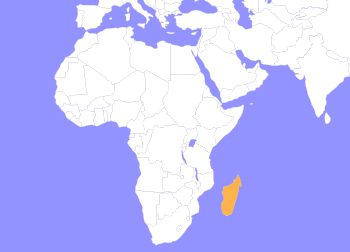Madagascar Hissing Cockroach
Centrochelys sulcata
Madagascar Hissing Cockroaches are popular pet roaches because of their unique characteristics and calm personalities. They are oval shaped, generally 2-3 inches long, with a black head and brown bodies. Males differ from females because they have black horns as well. These roaches get their name because they make a hissing sound when threatened or in a fight with another roach. They have small holes called spiracles that they can pass air through to make the noise. Currently, scientists know of 5 different types of hisses they can let out. The type of hiss may indicate combat, courting (two types of this one), mating, or an alarm. They are endemic to Madagascar, meaning they are only found on that island (besides being pets).
Though roaches gross out many people and are known for being pests, there are very few species that fit that bill. Madagascar Hissing Cockroaches, for instance, would not be able to live in city-like conditions as there would be very little food for them to eat. With proper housing, they can live 2-5 years in captivity. This species are great starter insects because they can’t fly, don’t bite or smell, and are pretty inactive

This species of cockroach are native to the island of Madagascar, located off the African mainland.
HABITAT -They are found in the tropical lowland rainforests of Madagascar in the leaf litter.
DIET -Being detritivores, they eat decaying plant and animal matter.
FUN FACT -They make their signature hissing sound by blowing air through holes in their bodies.
SOCIAL BEHAVIOR -Docile to humans, males can be territorial but will live together in high numbers.
ACTIVITY -They are nocturnal and will do their best to avoid light.
PREDATORS -Known predators are spiders, ants, tenrecs, and some birds.
SIZE -They grow to be 2-4 inches, with males bigger than females.
RELATIVES -They are in the same family as the Dubia cockroach and the Giant burrowing cockroach.
CONSERVATION -They are not evaluated by the IUCN, but Madagascar has many species that need protection.
Cub Creek Animal Care Information
Housing - They are housed in a 20-gallon aquarium with plenty of places to hide, a cockroaches favorite thing to do! Along with access to fresh water, their enclosure is filled with cardboard egg trays that have lots of nooks and crannies for them to hide in or under.
Diet - Our cockroaches are fed an herbivorous diet, getting fresh lettuce every day. Because they are detritivores, they also get mushrooms or dead insects as treats.
Enrichment - Invertebrates get much of their enrichment through exploration of their enclosure, rather than the toys or puzzle boxes that we provide for much of our other animals. Our campers give them additional stimulation by handling them throughout the summer.

